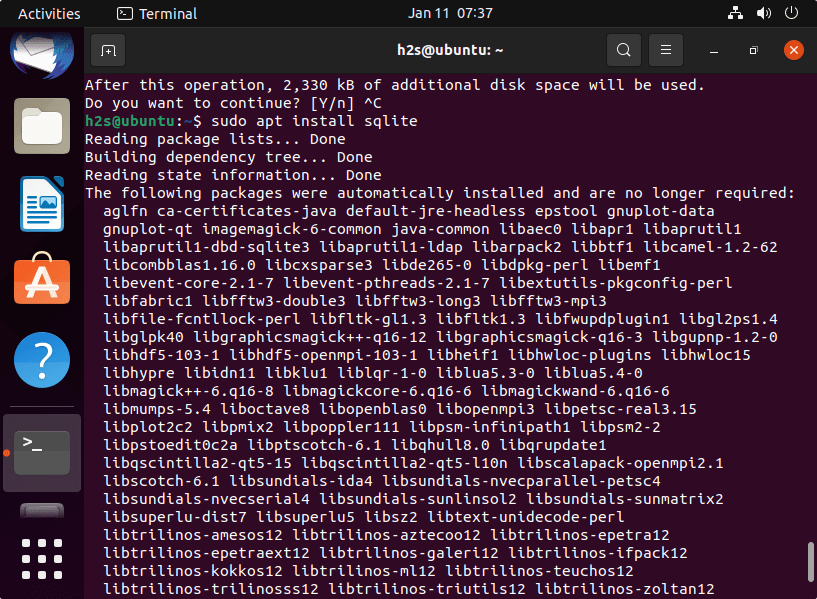

- #How to install sqlite on ubuntu 16.04 driver#
- #How to install sqlite on ubuntu 16.04 upgrade#
- #How to install sqlite on ubuntu 16.04 code#
- #How to install sqlite on ubuntu 16.04 password#

Now that you’ve installed all the packages that are required for BookStack to function, continue below to start configuring the servers. then browse to your server hostname followed by /phpinfo.php Then type the content below and save the file. To test PHP 7.2 settings with Apache2, create a phpinfo.php file in Apache2 root directory by running the commands below To restart Apache2, run the commands below Step 3: Restart Apache2Īfter installing PHP and related modules, all you have to do is restart Apache2 to reload PHP configurations. file_uploads = OnĪfter making the change above, save the file and close out. Then make the changes on the following lines below in the file and save. The value below are great settings to apply in your environments. Sudo apt install php7.1 libapache2-mod-php7.1 php7.1-common php7.1-sqlite php7.1-curl php7.1-intl php7.1-mbstring php7.1-xmlrpc php7.1-mysql php7.1-gd php7.1-xml php7.1-cli php7.1-mcrypt php7.1-tidy php7.1-zipĪfter installing PHP 7.1, run the commands below to open PHP default config file for Apache2. Next, run the commands below to install PHP 7.2 and related modules.
#How to install sqlite on ubuntu 16.04 upgrade#
Run the commands below to add the below third party repository to upgrade to PHP 7.1 sudo apt-get install software-properties-common in order to install it, you will have to get it from third-party repositories. PHP 7.1 may not be available in Ubuntu default repositories. if successful, you should see MariaDB welcome message Step 3: Install PHP 7.1 and Related Modules
#How to install sqlite on ubuntu 16.04 password#
Then type the password you created above to sign on. To test if MariaDB is installed, type the commands below to logon to MariaDB server Remove test database and access to it? : Y.Enter current password for root (enter for none): Just press the Enter.

This method works on my Ubuntu 16.04 VM with Python 3.7.3.
#How to install sqlite on ubuntu 16.04 code#
And your test code will be like the following: # import sqlite3
#How to install sqlite on ubuntu 16.04 driver#
This will import the SQLite3 DB-API 2.0 driver from the custom pysqlite module. Instead of using import sqlite3 to import the pysqlite3 module, use from pysqlite3 import dbapi2 as sqlite3. Now, the seperate pysqlite module should be installed onto your virtual environment. (python37env) $ python setup.py build_static build So you can use it to replace the original driver. The author of this article ( ) took SQLite3 DB-API 2.0 driver from Python 3 as a separate package ( enter link description here).

configureīefore you move on, you may want to activate your virtual environment. These two articles ( Force Python to forego native sqlite3 and use the (installed) latest sqlite3 version and ) could be a solution to the issue.ĭownload the SQLite source code and build it with FTS5 enabled. How can I use the FTS5 extension with the sqlite3 Python module with Python 3.7 on Ubuntu 16.04? Sqlite3.OperationalError: no such module: fts5 > conn.execute("""create virtual table fts5test using fts5 (data) """) Type "help", "copyright", "credits" or "license" for more information. However, if I change the Ubuntu version from 18.04 to 16.04, then the FTS5 extension doesn't work: docker pull ubuntu:16.04 # This line is optional.ĭocker run -interactive -tty ubuntu:16.04 bash For example one can run it via Docker with the following python3.7 interpreter: docker pull ubuntu:18.04 # This line is optional.ĭocker run -interactive -tty ubuntu:18.04 bashĪpt install -y software-properties-common The code works fine on Ubuntu 18.04 and Ubuntu 19.04. Values ('this is a test of full-text search') """)Ĭonn.execute("""select * from fts5test where data match 'full' """).fetchall() To test whether the FTS5 extension with the sqlite3 Python module works, I use this code from Vorsprung durch Technik: import sqlite3Ĭonn.execute("""create virtual table fts5test using fts5 (data) """)Ĭonn.execute("""insert into fts5test (data)


 0 kommentar(er)
0 kommentar(er)
